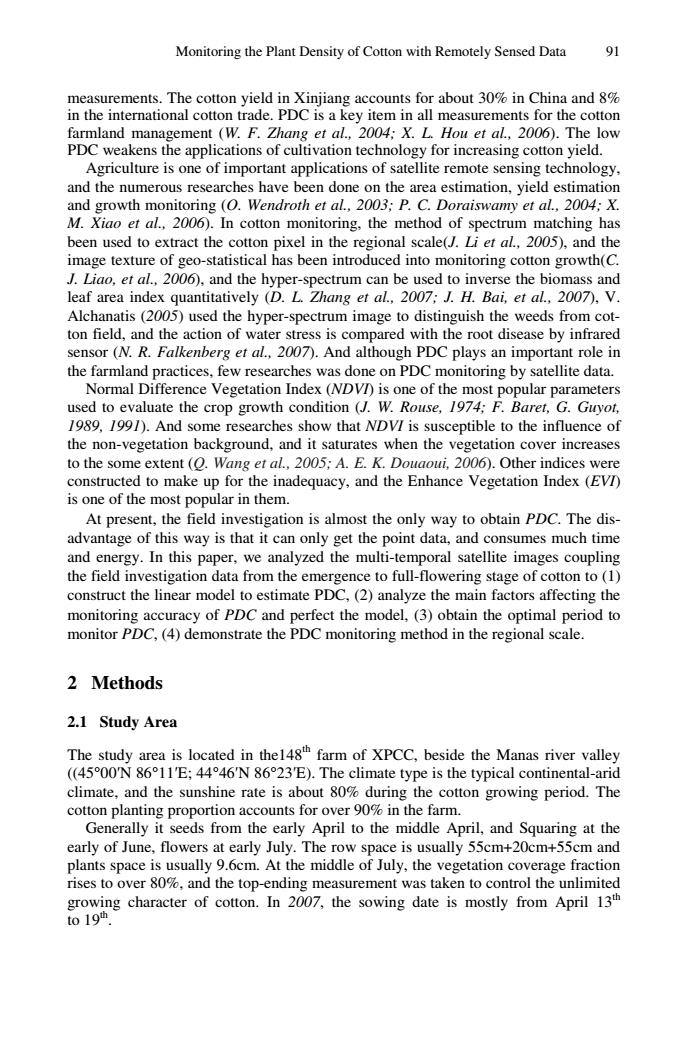正在加载图片...

Monitoring the Plant Density of Cotton with Remotely Sensed Data 91 PDC weakens the land ent (W.E.Zho 2004:X.L Hou 2006.Ths vation technology for increasing cotton yield. Agriculture is one of imp rtant a and the the ar yield itorins (O.Wendroth et al.2003:P.C.Dore al.2004:X eal.2006.i cotton m onito method of P atching ha been use ract the el in th ale(J. L et al. 200),and mage textur tis on growth( Liao,et a 2006),and th rse the area ind .Bal,er a 2007.V Alchan atis (2005)used the hyper-spectrum image to distinguish the weeds from cot- ton hield and the action of water stress is compared with the root disease by infrared sensor (N.R.Falkenberg et al.,2007).And although PDC plays an important role in the farmland practices,few researches was done on PDC monitoring by satellite data. Normal Difference Vegetation Index(NDVD)is one of the most popular parameters used to evaluate the crop growth condition (J.W.Rouse,1974:F.Baret,G.Guyot. 1989.1991).And some researches show that NDVI is susceptible to the influence of the non-vegetation background.and it saturates when the vegetation cover increases to the some extent (O.Wang et al.,2005:A.E.K.Douaoui,2006).Other indices were constructed to make up for the inadequacy,and the Enhance Vegetation Index(EVI) is one of the most popular in them. At present,the field investigation isamost the ony way toobtain PC.The dis of thi way is that it ca t the point data and umes much time the p an we analyzed the vestigation data from the em mporal atellite images couplin ergence to full-fl wering stage of co otton to (I construct the linear model to estimate PDC.(2)analyze the main factors affecting the monitoring accuracy of PDC and perfect the model,(3)obtain the optimal period to monitor PDC,(4)demonstrate the PDC monitoring method in the regional scale. 2 Methods 2.1 Study Area locnthe farm of XPCC.besie the Manas river valle E). e typ e is the typical continent climate,and the sunshine rate is ing the cotton growing period.The heand ra the for over 90% in the farm early of June,flowers at early July.The row space is usually 55cm+20cm+55cm and plants space is usually 9.6cm.At the middle of July.the vegetation coverage fraction rises to over 80%.and the top-ending measurement was taken to control the unlimite character of cotton.In 2007.the sowing date is mostly tromMonitoring the Plant Density of Cotton with Remotely Sensed Data 91 measurements. The cotton yield in Xinjiang accounts for about 30% in China and 8% in the international cotton trade. PDC is a key item in all measurements for the cotton farmland management (W. F. Zhang et al., 2004; X. L. Hou et al., 2006). The low PDC weakens the applications of cultivation technology for increasing cotton yield. Agriculture is one of important applications of satellite remote sensing technology, and the numerous researches have been done on the area estimation, yield estimation and growth monitoring (O. Wendroth et al., 2003; P. C. Doraiswamy et al., 2004; X. M. Xiao et al., 2006). In cotton monitoring, the method of spectrum matching has been used to extract the cotton pixel in the regional scale(J. Li et al., 2005), and the image texture of geo-statistical has been introduced into monitoring cotton growth(C. J. Liao, et al., 2006), and the hyper-spectrum can be used to inverse the biomass and leaf area index quantitatively (D. L. Zhang et al., 2007; J. H. Bai, et al., 2007), V. Alchanatis (2005) used the hyper-spectrum image to distinguish the weeds from cotton field, and the action of water stress is compared with the root disease by infrared sensor (N. R. Falkenberg et al., 2007). And although PDC plays an important role in the farmland practices, few researches was done on PDC monitoring by satellite data. Normal Difference Vegetation Index (NDVI) is one of the most popular parameters used to evaluate the crop growth condition (J. W. Rouse, 1974; F. Baret, G. Guyot, 1989, 1991). And some researches show that NDVI is susceptible to the influence of the non-vegetation background, and it saturates when the vegetation cover increases to the some extent (Q. Wang et al., 2005; A. E. K. Douaoui, 2006). Other indices were constructed to make up for the inadequacy, and the Enhance Vegetation Index (EVI) is one of the most popular in them. At present, the field investigation is almost the only way to obtain PDC. The disadvantage of this way is that it can only get the point data, and consumes much time and energy. In this paper, we analyzed the multi-temporal satellite images coupling the field investigation data from the emergence to full-flowering stage of cotton to (1) construct the linear model to estimate PDC, (2) analyze the main factors affecting the monitoring accuracy of PDC and perfect the model, (3) obtain the optimal period to monitor PDC, (4) demonstrate the PDC monitoring method in the regional scale. 2 Methods 2.1 Study Area The study area is located in the148th farm of XPCC, beside the Manas river valley ((45°00′N 86°11′E; 44°46′N 86°23′E). The climate type is the typical continental-arid climate, and the sunshine rate is about 80% during the cotton growing period. The cotton planting proportion accounts for over 90% in the farm. Generally it seeds from the early April to the middle April, and Squaring at the early of June, flowers at early July. The row space is usually 55cm+20cm+55cm and plants space is usually 9.6cm. At the middle of July, the vegetation coverage fraction rises to over 80%, and the top-ending measurement was taken to control the unlimited growing character of cotton. In 2007, the sowing date is mostly from April 13th to 19th